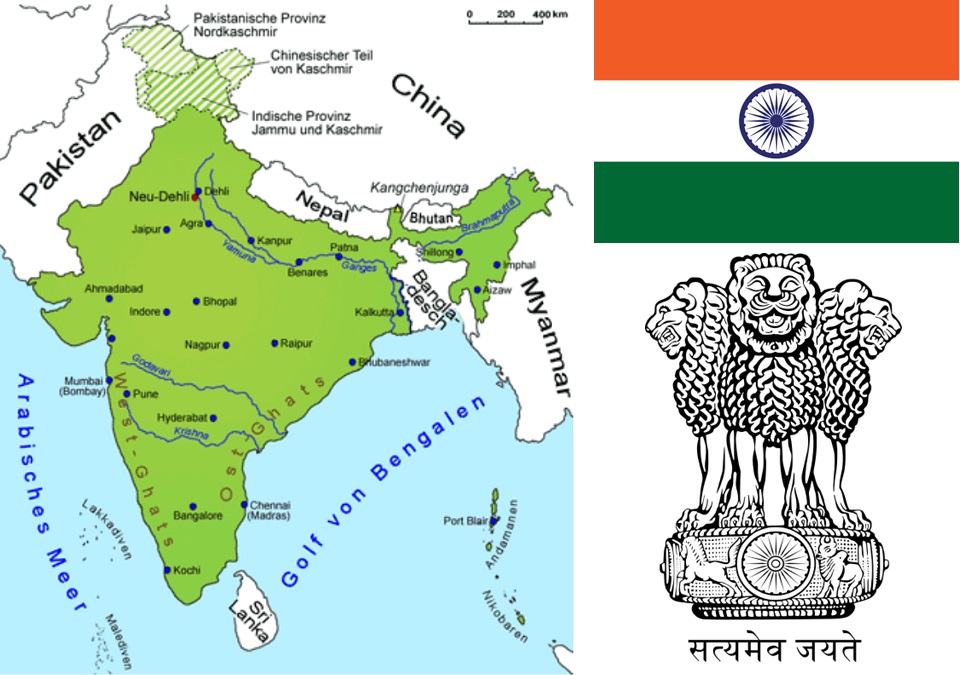The parliamentary Federal Republic of India (Hindi भारत गणराज्य, Bhārat Gaṇarājya) in South Asia with its capital New Delhi covers the largest part of the Indian subcontinent at 3,287,263 km². The Himalayas form the natural northern border and the Indian Ocean encloses the national territory in the south. India borders Pakistan, Tibet, Nepal, Bhutan, Myanmar and Bangladesh. Other neighbouring countries in the Indian Ocean are Sri Lanka and the Maldives. Non-violent resistance against British colonial rule under Mahatma Gandhi (1869-1949) and Jawaharlal Nehru led to independence in 1947.

History
In the second millennium BC, the Aryans migrated to north-west India via the Hindu Kush. The Vedas, the holy scriptures of Hinduism, were written in the period up to 800 BC, which is known as the Veda culture. Two alcoholic drinks are mentioned in them.Soma", a milk-like drink with a drug-like effect made from fly agaric, datura or rhubarb, was served as an offering. The second was "sura", fermented from barley or rice.
The highest Vedic god was the hard-drinking Indra. However, the fifth of the ten commandments of Buddhism forbids the consumption of alcohol. However, Buddha (563-483 BC) himself had a milder attitude towards alcohol and merely described it as a "consumer of wealth". The minister of the Maurya king Chandragupta (around 300 BC) named Kautilya wrote the famous "Arthasastra", similar to the writings of Machiavelli. In it, he mentions a wine made from grapes called "Madhu".
For centuries, however, wine was only drunk by the privileged, such as warriors and nobles. The common people brewed alcoholic drinks from barley, rice and millet. Due to colonisation by the Portuguese in the 16th century and the English in the 19th century, there was limited regional viticulture, but the entire vineyards fell victim to phylloxera around 1890. Later, French missionaries planted vineyards near Madras.
From 1950 onwards, there was a temporary prohibition in individual federal states; Haryana was the last federal state to lift this prohibition in 1998. In the state of Karnataka, wine has no longer been considered an alcoholic beverage since 2008 and can now be sold not only in licensed alcohol shops, but also in supermarkets and other shops. Wine has thus been equated with non-alcoholic drinks. However, the rule does not apply to fortified wines.
Wine-growing regions
The climate is characterised by hot summers with high humidity and the heavy Indian monsoon in summer and winter. From a climatic point of view, however, there is no winter, so two harvests a year are or could be possible. This is because most winegrowers cut away the grapes from the monsoon season long before they ripen in order to allow the plant to rest.
In the meantime, attempts are being made to plant vineyards much higher up, forcing the vines to hibernate, as in Europe, due to the cold. Most of the vineyards are located in south-central India in the states of Maharashtra (the valley on the holy river Godavari north of Nasik is actually sometimes referred to as the Napa Valley of India), Karnataka and Andhra Pradesh. The rest is in the north-west in the state of Punjab. The vines are often trained in the lyre system to keep the grapes off the ground during the rainy season.
Grape variety level
In 2022, the total area under vines was 170,000 hectares. Only a few thousand hectares are used for wine grapes, which yielded around 180,000 hectolitres of wine. The majority of the harvest is used for the production of sultanas, table grapes and grape juice. The grape variety index; "*" means wine grape and table grape (Kym Anderson statistics):
Grape variety |
Colour |
Synonyms or name in India |
Hectare |
| Sultana (*) | white | Sultaniye | 1.000 |
| Sauvignon Blanc | white | - | 500 |
| Syrah | red | - | 500 |
| Trebbiano Toscano | white | - | 300 |
| Cabernet Sauvignon | red | - | 100 |
| Chardonnay | white | - | 100 |
| Muscat d'Alexandrie | white | - | 100 |
| Pinot Noir | red | - | 100 |
| Anab-e-Shahi (*) | white | - | ? |
| Arka varieties (*) | red and white | - | ? |
| Bangalore Purple (*) | - | - | ? |
| Chenin Blanc | white | - | ? |
| Isabella (*) | red | Bangalore Blue | ? |
| Merlot | red | - | ? |
| Muscat d'Hamburg (*) | red | Gulabi | ? |
| Perlette | white | - | ? |
| Viognier | white | - | ? |
Producers
Indian viticulture is developing rapidly with annual growth rates of up to 30%. The Andhra Winery & Distillery, founded in 1966 in Malkajgiri in the state of Andhra Pradesh, is regarded as the starting point. In the early 1980s, Château Indage, which produces around 70% of India's wine, was established east of Bombay in Náráyangoan (Maharashtra) with European support. Near the city of Bangalore, the Grover V ineyards winery was founded in the Dodballapur mountains (Karnataka) in 1988 and the Sula winery (Maharashtra near Nasik) in 1997. There is an increasing number of other European investors such as Diageo with the Nila brand and Pernod Ricard with the Nine Hills winery.
Map: © Goruma
Flag: of Federal Government of India - Public domain, Link
Coat of arms: by Government of India - Public domain, Link
Voices of our members

For me, Lexicon from wein.plus is the most comprehensive and best source of information about wine currently available.
Egon Mark
Diplom-Sommelier, Weinakademiker und Weinberater, Volders (Österreich)